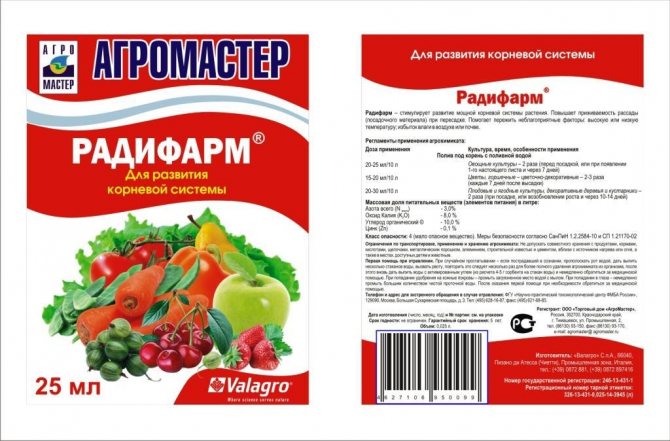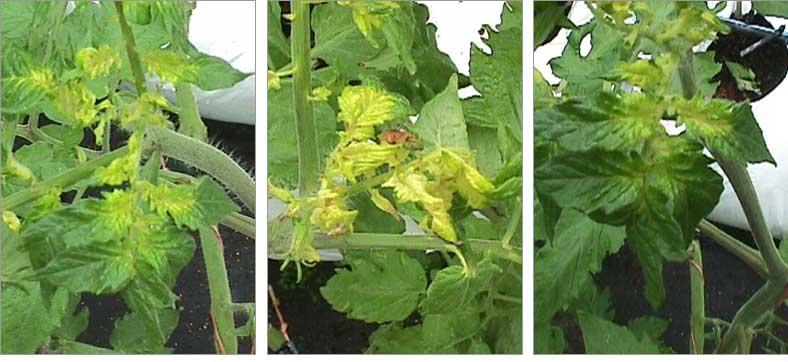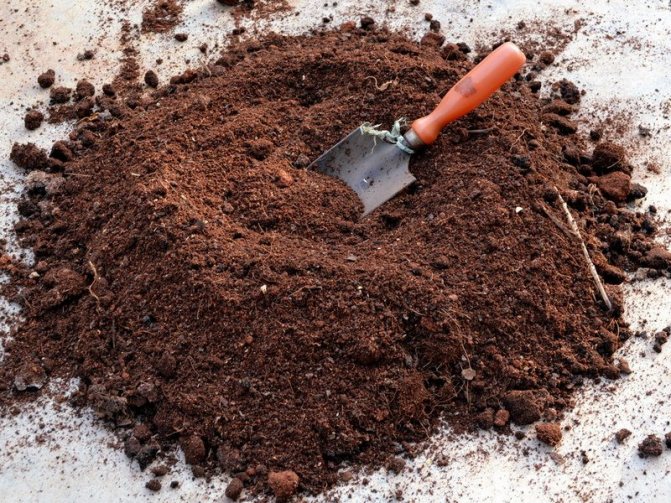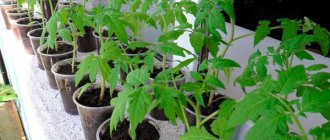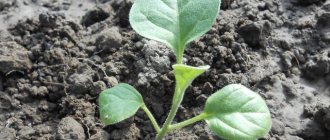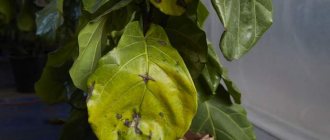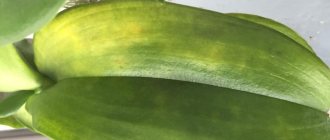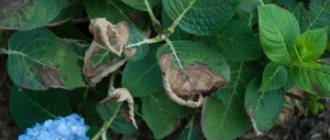Tomatoes are considered a capricious crop. If you are just starting to grow them, you may encounter problems such as yellowing and dry leaves. What contributes to the appearance of yellow spots? What means to use for treating bushes? You can find out about all this from our publication.
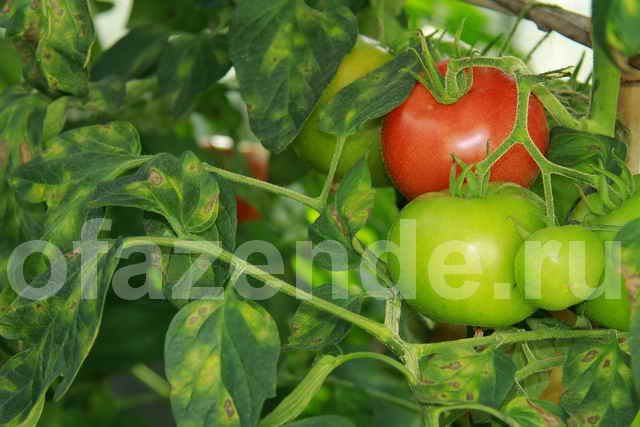
The leaves of tomatoes turn yellow. Illustration for this article is used under a standard license <431
The reasons from which the leaves on tomatoes dry and turn yellow
Growing tomatoes is a painstaking process that requires a lot of effort, time and, of course, patience. It is especially difficult for novice vegetable growers who have no practical experience in agricultural technology in general for vegetable crops.
Tomatoes are grown both outdoors and indoors. Those tomatoes that grow in greenhouse conditions are better protected from negative environmental influences. For example, bad weather. Tomatoes growing in the greenhouse do not need to be additionally protected from strong wind, sun or unexpected frosts. In some ways, care is easier under these conditions. It is enough to create the desired microclimate.
However, there are difficulties in growing tomatoes and in the greenhouse. One of the common problems is drying and yellowing of leaves on tomatoes in a greenhouse. These are two different problems.
Often appear at the same time or one after the other. For example, at first the leaves turn yellow, and then dry, or vice versa.
The content of the article:
1.What tomatoes need 2.Reasons why tomato leaves dry and turn yellow in a greenhouse 2.1 Microclimate in a greenhouse 3.Why leaves of tomatoes growing in a greenhouse dry 3.1 Temperature and humidity 3.2 Lack of nutrients or excessive feeding of tomatoes 4.Possible diseases of tomatoes, leading to yellowing of leaves 5.How to help tomatoes 6.Insect pests of tomatoes 7.Reasons for the appearance of yellowness on the leaves of tomatoes growing in a greenhouse 7.1 Injuries to the root system of tomatoes 7.2 Frequency of watering 7.3 With a lack of moisture 7.4 With an excess of moisture 7.5 Unbalanced nutrition of plants 8.Diseases tomatoes, leading to yellowing of leaves 9.Insect pest damage to tomatoes and yellowing of foliage
Non-compliance with the temperature regime
If there are sudden temperature changes in the greenhouse during the day and night, this negatively affects the seedlings. If the leaves turn yellow and dry out, this is speaks of overheating of seedlings... With hypothermia, the leaves turn yellow, lose their elasticity and wither. This indicates poor performance of the root system.
You can prevent temperature drops in the greenhouse using barrels of water... In the daytime, water heats up, absorbing heat, at night it gives it off.
What tomatoes need
It is worth saying a few words about what is required for a tomato crop cultivated in greenhouse conditions.
Photo of yellowing foliage in tomatoes
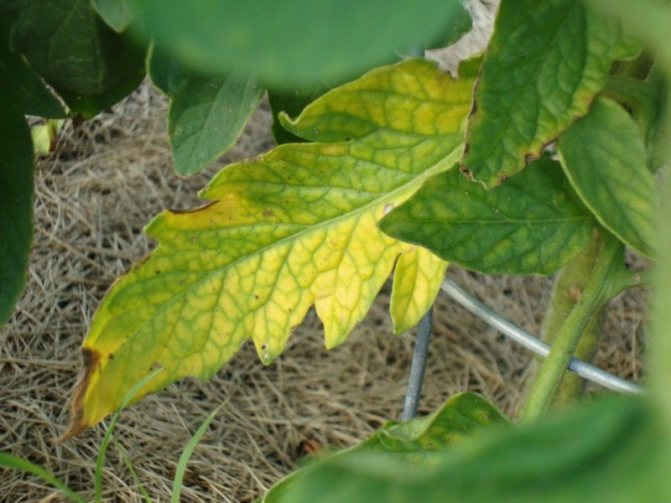

Requirements:
- systematic watering;
- maintaining the required humidity level (60 - 70%);
- monitoring the temperature inside the greenhouse (from +23 to 30 degrees);
- ensuring a sufficient amount of light access, excluding direct rays of the sun.
These conditions need to be created already at the initial stage of seedling. Periodically, it is necessary to carefully examine the tomato bushes in order to take timely measures if a problem is detected, for example, yellowing of the leaves.
Caring for tomatoes in the greenhouse - video
Important!
Drying and yellowness on tomato leaves is a serious problem that you need to immediately pay attention to and start looking for the cause of its appearance.
Lack of nutrients
The appearance of yellow leaves on tomatoes in a greenhouse can be a signal that plant feeding is not being carried out correctly. It is possible that the wrong fertilizers are being applied or in the wrong quantities.
At all stages of development of a garden culture, potassium, nitrogen, magnesium and other macro- and microelements are needed. Their lack, like an overabundance, negatively affects not only the greens of the tomatoes, but also the plant as a whole.
If the sprouts of the culture are weak, with thin stems, small leaves, the tomatoes receive less nitrogen. In this case, the plant is watered using nitrogen-containing fertilizers. The simplest solution is to water the tomatoes:
- urea solution;
- infusion of manure.
The lack of potassium is indicated by the appearance of small yellow dots, which subsequently merge into a single yellow spot.
To replenish the potassium reserves in tomato beds, you need to water them with a potassium sulfate solution.
With a lack of manganese, young leaves first begin to turn yellow, and only then old ones. Lacking reserves of phosphorus lead not only to the appearance of yellow leaves, but also to their subsequent withering away. By twisting the yellowed leaves, the plant reacts to a lack of magnesium.
How to fix the situation
The solution to the problem is the correct feeding of the tomato beds. The best option would be to apply a complex fertilizer offered in specialized stores. They contain all the nutrients necessary for vegetable crops.
If you give preference to folk methods, it is enough to use chicken droppings. First, a mother liquor is prepared, after which every 2 liters is diluted with a bucket of clean water and the tomato beds are watered.
If healthy leaves began to turn yellow on tomatoes in a greenhouse, an urgent need to establish the cause. Yellow leaves cannot be ignored, because the consequence of this can be a lack of harvest, complete destruction of plants, contaminated soil and proliferated insects.
Reasons why tomato leaves dry and turn yellow in a greenhouse
The yellowness and drying of tomato leaves occurs for various reasons. Some lead only to yellowing, others - to drying and curling of the leaves. In either case, it is important to maintain the microclimate in the greenhouse, so this reason can be attributed to both cases.
Why do the leaves of tomatoes turn yellow in a greenhouse - video
Microclimate in the greenhouse
An inappropriate microclimate inside the greenhouse can ruin all tomato plantings.
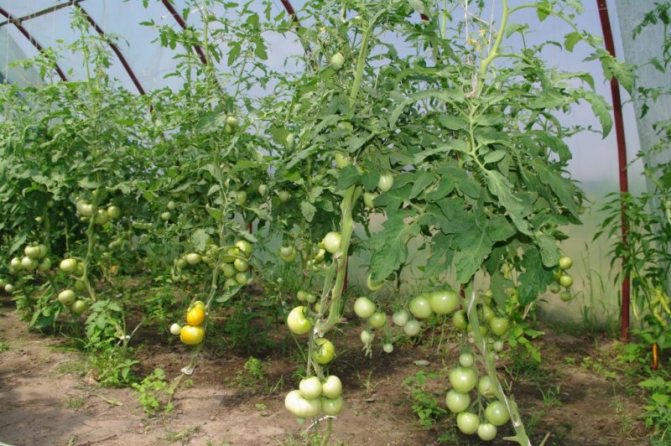

The first thing to do is to understand the construction of a greenhouse structure and observe the following rules:
- You need to build a greenhouse in a place well protected from the winds. Preference should be given to a site surrounded by buildings or garden plantings of appropriate growth, for example, tall trees, shrubs. This is especially true during lunch, when the scorching sun is present. Such rays will heat the greenhouse and raise the temperature inside it, in some cases, up to + 45 degrees. Dumping of ovaries, flowers and the formation of yellowness on the leaves of tomatoes will begin.
- Replace the soil annually. After all, it is in it that fungal spores, bacteria, infectious pathogens settle. When it is not possible to completely change the soil, it is spilled with a solution of potassium permanganate or with boiling water a couple of days before placing tomato seedlings in it.
- At the onset of spring, disinfect structural elements, including processing all tools used in the greenhouse.
- Periodically, you need to ventilate the greenhouse with tomatoes to evaporate excess moisture.
- If necessary, increase the humidity by simply spraying with a spray bottle. You can simply install open containers filled with water.
- Create a heating system that can be used as needed.
Choosing tomatoes!
Tomato Country delicacyTomato Pride of SiberiaTomato King of Giants
Attention!
The most favorable environment for the growth of fungi and infection is moisture and warmth. This applies more to the greenhouse, since it is here that there is such a problem as high humidity and high air temperature.
![Tinkoff (Debit Card) [CPS] RU](https://bgn.imadeself.com/wp-content/uploads/tinkoff-debetovaya-karta-cps-ru12.jpg)
![Tinkoff (Debit Card) [CPS] RU](https://bgn.imadeself.com/wp-content/uploads/tinkoff-debetovaya-karta-cps-ru12.jpg)
Lack of trace elements in the soil
It is very important for tomatoes to have enough minerals in the soil. Their lack leads to yellowing of the leaves.
Signs of micronutrient deficiencies:
- Nitrogen deficiency... With a lack of nitrogen in the soil, the plant will be weak, with a thinned stem, small foliage. The lower leaves begin to turn yellow and the veins become bluish in color. This drawback can be eliminated by watering with a mullein solution: for 10 liters of water, 1 liter of fermented mullein and 200 grams of ash.
- Lack of magnesium... The leaves are covered with brown-brown spots and fall off. You can eliminate it by applying fertilizers with magnesium nitrate.
- Potassium deficiency... The leaf becomes covered with yellow spots and curls. Until the fruit sets, it is necessary to make a top dressing based on potassium chloride, then potassium phosphate can be used.
- Lack of sulfur... The leaves are covered with brown-brown spots and fall off. In the process of fruiting, add fertilizing twice with a high sulfur content.
- Boron deficiency... The leaf at the top of the bush turns yellow. Apply boric acid-based fertilizing.
- Manganese starvation... The leaves are light yellow in color. Young leaves are affected first, and then old ones.
In the latter case, it is necessary to add to the soil fermented mullein solution, diluted in the ratio:
- mullein -1 liter
- water - 20 liters
It is also recommended to spray tomato bushes. potassium permanganate solution in relation to:
- warm water - 10 liters
- manganese - 1 tablespoon
Why do the leaves of tomatoes growing in a greenhouse dry: possible causes
Let's try to figure out, according to certain signs, what is the reason for the yellowing of the leaves and tops of tomatoes that affected your garden.
Temperature and humidity
A common reason for drying and curling of tomato leaves is an increased air temperature of + 35 degrees, a lack of sufficient oxygen and lighting.
Photo of curling tomato leaves
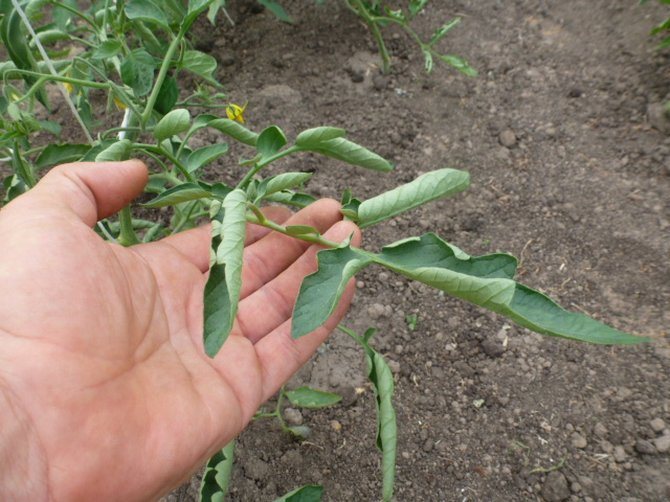

It is worth remembering!
The lack of light is more damaging to the health of tomatoes than heat. Therefore, for example, in those regions of the country where the daylight hours are short, it is necessary to additionally use artificial lighting.
Lack of nutrients or over-feeding of tomatoes
The next reason:
lack or excess of trace elements and other nutrients. An important reason for the wilting of tomato leaves is improper feeding. Often there is an excess of the fertilization measure with organic matter, nitrogen, and herbal infusions. In such cases, the leaves begin to dry either from the edges or from the center.
Photo of excess nitrogen in tomatoes
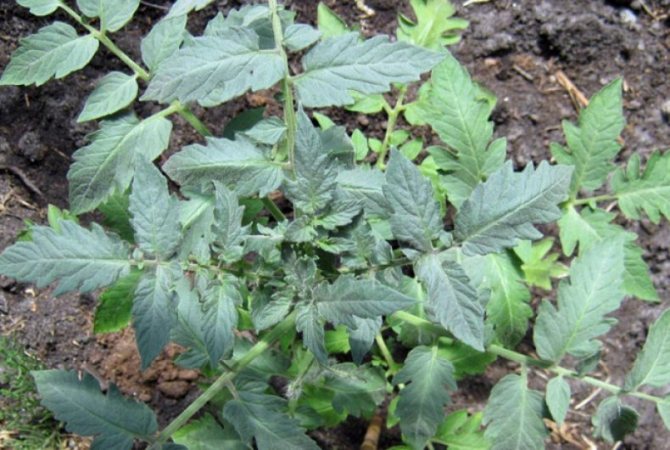

When there is too much nitrogen, a vigorous growth of green mass and shedding of flowers begins. To restore the balance, watering or spraying with a solution with wood ash is carried out. Potash fertilizers are sometimes used.
Lack of nitrogen is more dangerous for tomatoes, as it can lead to their death.
Photo of a sign of potassium deficiency in tomatoes
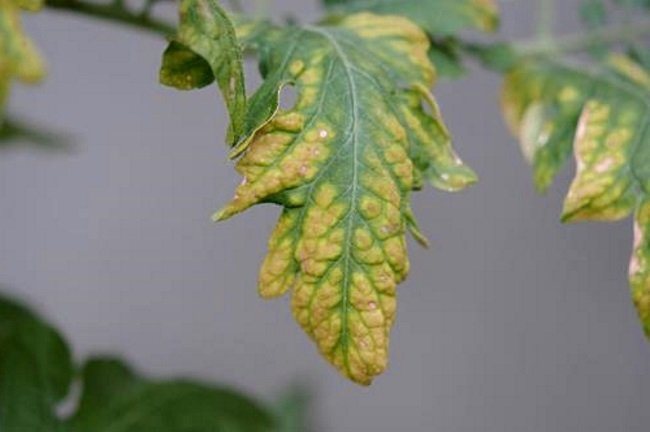

Potassium deficiency also leads to yellowing of the green mass. This is the first sign that the soil is lacking this trace element. To compensate for the deficiency, wood ash, potassium nitrate and other dressings are used.
Heavy acidic soil
Tomatoes do not tolerate heavy soil and high acidity... It is better to prepare the soil for tomatoes yourself before planting.
It is necessary to mix in equal parts garden soil, peat and sifted river sand and add ash to normalize the acidity level. The soil is necessary loosen after each wateringto prevent stagnation of moisture in the soil, leading to soil acidification.
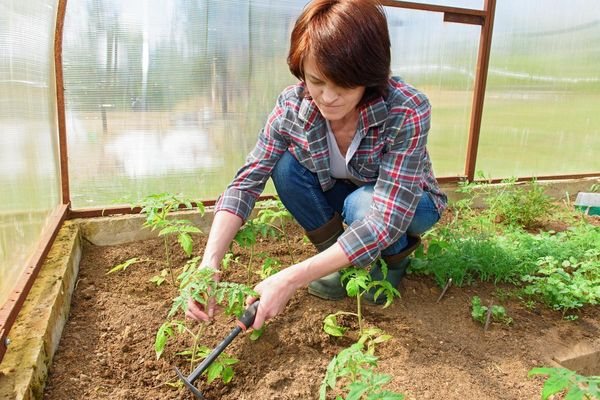

When loosening, additional oxygen is supplied to the roots
When loosening, additional oxygen is supplied to the roots, which ensures normal plant growth. Lack of these measures leads to yellowing.
Possible diseases of tomatoes, leading to yellowing of tomato leaves and their wilting
Dry leaves can be the result of damage to tomatoes by tobacco mosaic, late blight, curl virus, fusarium wilt.
How to determine a tomato disease by a leaf - video
Tobacco mosaic.
The first sign of the disease is the appearance of spots on the leaves, which gradually spread to the entire plant and affect the fruits themselves, making them unsuitable for food. If a disease is detected, action must be taken immediately, because its development occurs very quickly.
Photo of tomato mosaic


Late blight.
It is a fungal disease. It is quite common among vegetable crops. The very first sign is the appearance of a white bloom on the sheet plate. The lower parts of the leaves become dark, spots appear on them, and the foliage dries and falls off.
Photo of late blight in tomatoes
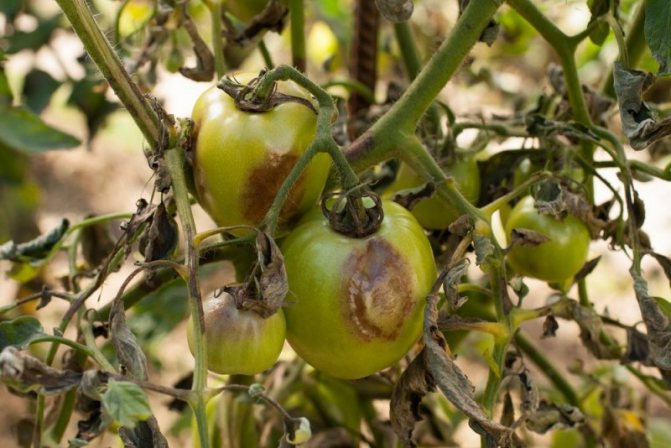

Fusarium (or fusarium wilting)
able to destroy tomatoes. The fungus penetrates through the soil into the root system and gradually spreads to the entire plant, penetrating the foliage and fruits. In the presence of a disease, you can notice a rapid wilting, twisting and falling of the lower leaves.
Photo of fusarium (or fusarium wilting)
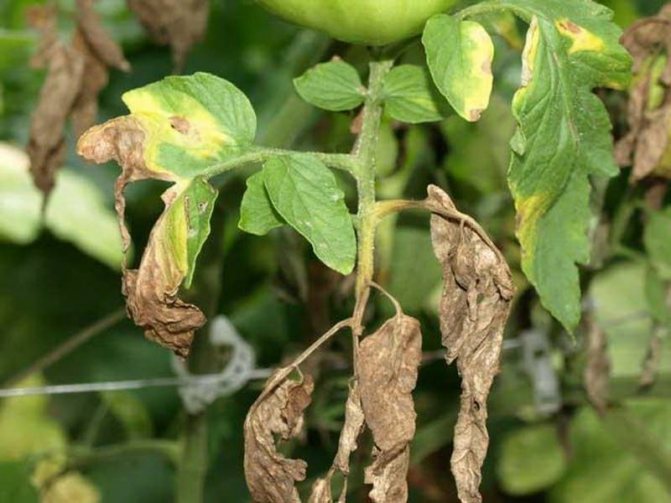

Curl virus
- a viral disease, as a result of which the curling and wilting of tomato leaves also occurs. At first, you can notice a change in the color of the leaves, crushing of the green mass, and its twisting.
Photo of curl virus
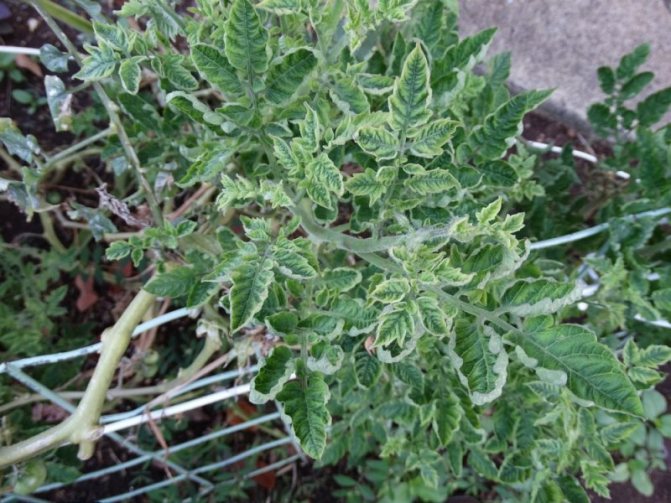

Tomatoes: what kind of culture?
The homeland of tomatoes is South America. It is an annual thermophilic plant of the Solanaceae family. Characteristics:
- stem - erect, slightly pubescent;
- flowers are yellow;
- ovaries - elongated, spherical;
- fruits are round, juicy.
Tomatoes are whimsical plants. They need plenty of warmth and light. The optimum temperature for seed germination is + 25-27 degrees, therefore, in Russian conditions, it is better to plant by seedling in greenhouses in early spring, because the growing season and development is quite long.
It is equally important to provide greenhouse tomato seedlings with sufficient lighting. But the plants are undemanding to humidity, however, you need to water in moderation, otherwise the fruits will dry out and crack, the ovaries will fall off. Saplings will become frail, weak, unstable to fungal diseases.
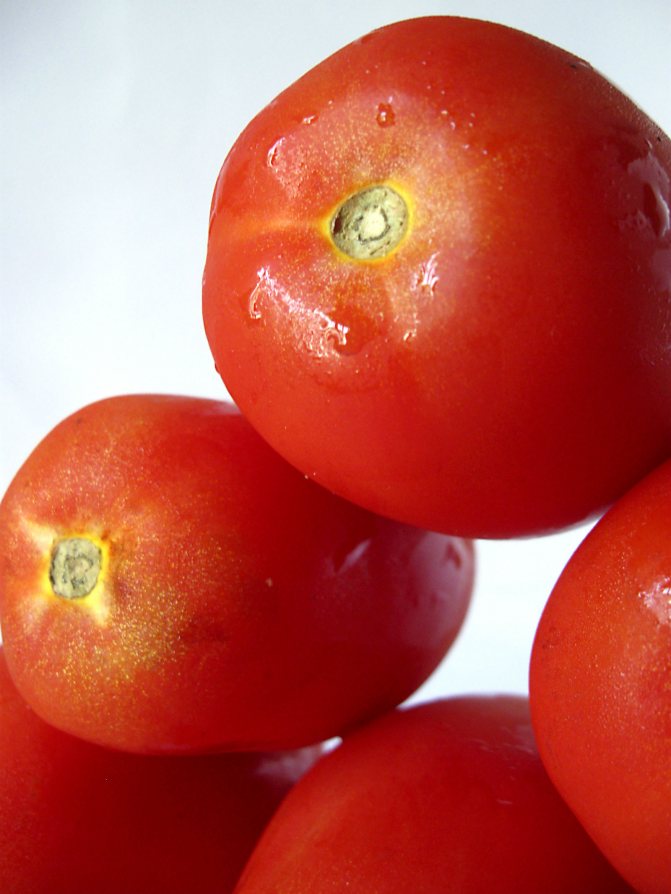

Tomatoes
Note! The leaves begin to turn yellow immediately when the root system is disturbed or the seedlings overgrow. If planted initially early, then when planted in open ground, the root system will be thinned and tangled into a lump.
How to help tomatoes
The first thing to do is to isolate the damaged plant parts and burn them.
Tomato disease!
Top rot of tomatoes in the greenhouse
The second is to treat the plants with chemicals in case of severe damage in accordance with the instructions.
When the disease has not yet spread, use non-traditional "folk" remedies.
Third, remember that prevention is better than cure, and therefore take preventive measures:
- maintain a favorable microclimate in the greenhouse (temperature, humidity);
- carry out correct, systematic care (watering, feeding).
Prevention will strengthen the immunity of tomatoes, and, accordingly, will minimize the risk of disease.
Diseases with yellow symptoms
Some fungal infections of tomatoes also begin with yellowing of the tops.
Fusarium
Lightening of the veins of the lower leaves and their twisting, accompanied by wilting of the top of the plant, despite sufficient watering, indicates that the plant is infected with Fusarium (dry rot). The source of infection are:
- seeds;
- priming;
- soil nematodes.
If previously the tomatoes in the garden were sick with dry rot and there are a lot of nematodes in the soil, re-infection will surely occur. A way out is varieties and hybrids resistant to fusarium: Alaska, Vologda F1, Charisma F1, etc.
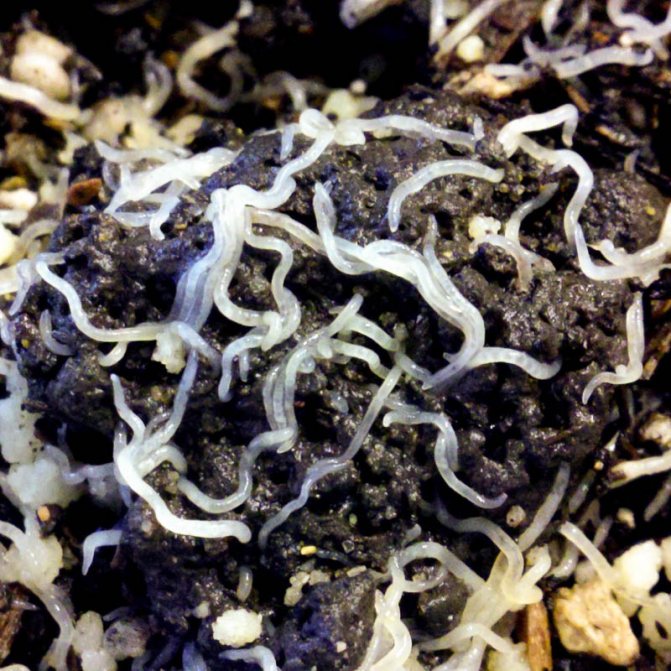

Soil nematodes are small but dangerous pests and disease vectors
Fusarium cannot be completely cured, fungi live inside the plant. To stop the development of the disease, the bushes are sprayed with systemic chemicals:
- Quadris;
- Optimo;
- Bayleton.
Contact drugs, biological and folk remedies with developed dry rot are useless.
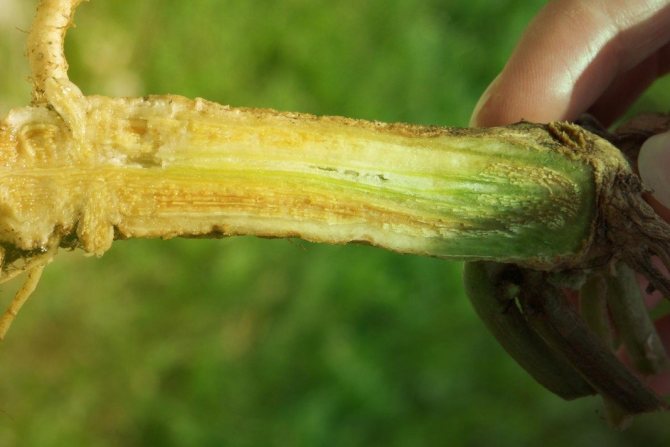

With fusarium, whitened clogged vessels are visible on the cut of the tomato stem, later they turn brown
Cladosporium
If chaotic small olive-yellow spots appear on the lower leaves, the tomato is infected with brown spot (cladosporiosis). Subsequently, the spots turn brown, the infection spreads to the upper tier, the leaves curl and dry out. The disease is curable with urgent spraying with drugs:
- HOM;
- Abiga Peak;
- Poliram.
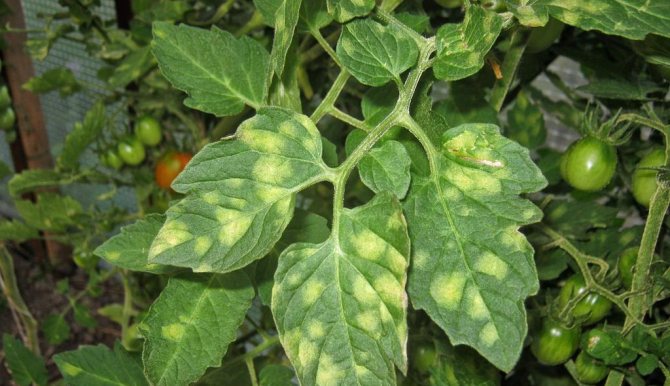

Cladosporium disease progresses rapidly, you can lose tomatoes in 2 weeks
To prevent yellowing of the leaves, observe the temperature and water regime, feed the tomatoes in a timely manner and carry out the prevention of diseases.
Infestation of tomatoes by insect pests
Insects - Pests are another reason why tomato leaves can dry out.
To determine the type of pest, you need to carefully examine the underside of the sheet plate. Most often, this problem is caused by the defeat of aphids, whiteflies, spider mites.
Small black specimens localized in the folds of the plant are aphids.
It is very dangerous, as it feeds not only on plant sap. The insect injects a substance into the plant itself, which leads to a change, a violation of the shape of the tomatoes.
Photo of aphids on tomatoes
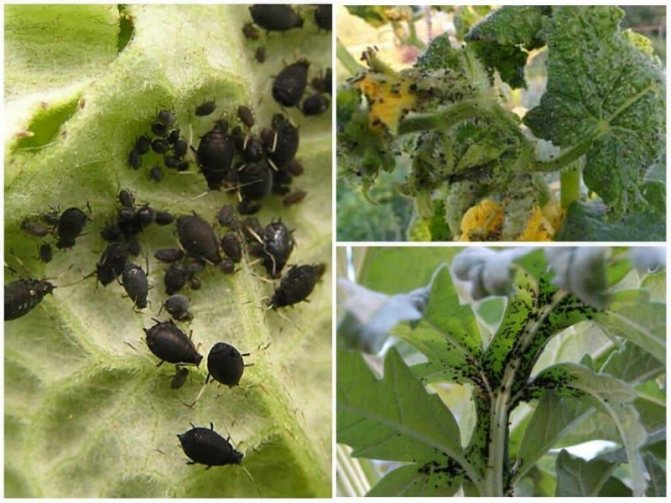

Whiteflies live in whole colonies and are represented by small white insects. The larvae eat almost all the green mass. Their waste products are dangerous for tomatoes, as they infect them with a fungus.
Photo of whiteflies on tomatoes


Spider mite is located on the bottom of the leaves
and is capable of hitting all tomatoes in a few weeks.
Photo of a spider mite on tomatoes
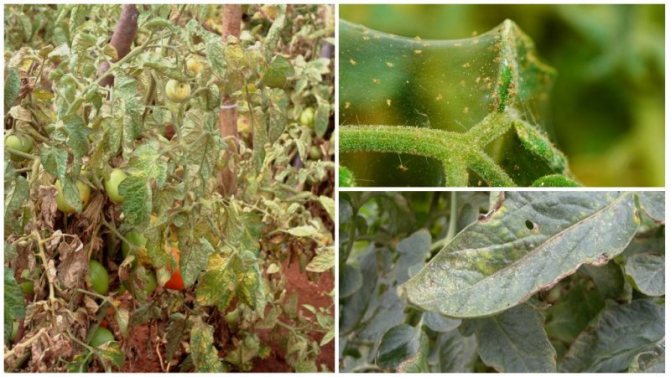

In the fight against pests, specialized insecticides, digging, soil replacement, mulching are used.
The reasons for the appearance of yellowness on the leaves of tomatoes growing in a greenhouse
The appearance of yellowness on the leaves can occur for various reasons.
Are the leaves of the tomatoes starting to turn yellow? What is the reason and what to do? - video
Here are the most common ones:
- inadequate humidity and temperature regime;
- non-compliance with the regularity and watering measures (lack or excess);
- the presence of damage to the root system;
- insufficiently enriched soil composition with useful substances;
- damage to plants by fungus or bacteria.
All of the above factors can lead to yellowing of the leaves. First you need to establish the cause, and then choose the treatment. In each case, the treatment will be different.
Tomato root system injuries
Tomatoes have a very developed root system.Tomato roots can grow up to 1.5 meters in length, so the culture thrives in dry periods. Some of the roots are above the surface of the soil and therefore systematic watering is required.


Causes of damage to the root system:
- At the seedling stage, too tight containers are used for growing tomatoes, which leads to twisting of the roots and reduces the possibility of rooting after planting in a new place.
- In the case of overgrowth of seedlings, adaptation is also difficult, which leads to the appearance of yellowness on the leaves of tomatoes.
- The presence of insects - pests. The most dangerous are the wireworm and the bear.
How to help:
for better adaptation to new conditions, it is required to fertilize tomato plants by spraying foliage from a spray bottle.
Watering frequency
When the yellowing starts at the bottom of the plant's leaves and gradually spreads higher, it may be caused by too moist soil or lack of moisture in the soil. With a lack and excess of moisture, yellowing of tomato leaves manifests itself in different ways.
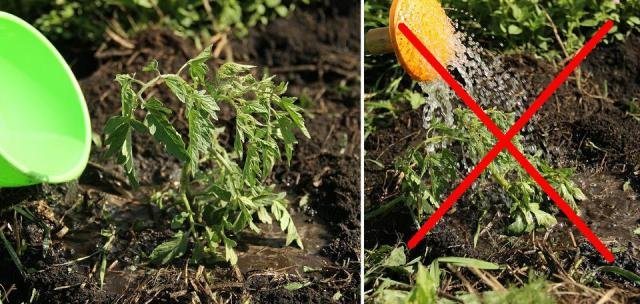

With a lack of moisture
When the tomatoes lack moisture, cracks appear in the soil, the shoots themselves become drooping, lethargic, and the leaves begin to sag.
Attention!
Some growers make the mistake of immediately increasing watering when yellowness is found on tomato leaves. You don't need to do this. And in the presence of fruits - even more so. Excessive humidity will cause the tomato crop to crack.
With dry soil, a smooth and gradual watering is carried out, that is, the moisture is gradually increased. And in order to avoid cracking of tomatoes, phosphorus fertilizing is introduced into the soil.
EXCELLENT VARIETIES OF TOMATOES!
GavrocheFlame sparksLiquor
With excess moisture
When the soil is waterlogged, this also has a bad effect on the condition of tomatoes and foliage.
This is manifested in the following:
- silting of the soil, the appearance of moss;
- shoots become elastic;
- there are foci of infection on tomato plants.
CHERRY TOMATOES!
Tomato "Leopold" F1
To reduce soil moisture, you need to follow several rules when watering:
- watering in the early morning or late evening (before 06:00 and after 18:00);
- use settled water at room temperature for irrigation;
- avoid getting water on the leaves and fruits of tomatoes, watering at the root (or drip irrigation);
- watering regularly, often 2 times a week is enough.
Attention!
Younger plants need more water. As the culture matures, its quantity should be reduced.
Unbalanced plant nutrition
Leaves can turn yellow equally on tomatoes in the case of a shortage and in case of an excess of nutrients. All that is required is to make top dressing in a timely manner and periodically inspect the seedlings.
What tomatoes are missing - Lack of nutrients - video
It is the leaves that signal whether the plant is getting enough nutrients.
With yellowing of the lower leaves and lethargy of the shoots, slow formation of shoots, as well as the small size of the leaves, the absence of inflorescences, the tomato plant lacks such a trace element as nitrogen.
To eliminate, either nitrophosphate or another mixture with a nitrogen content in the composition is introduced.
With a lack of potassium, many light dots appear on the leaves of tomatoes.
, which gradually grow and turn into one bright spot that covers the entire leaf plate. Potassium supplements are introduced.
When the leaves located at the top of the plant look drooping, then the tomatoes need to be fed with manganese
, for which wood ash or cow dung is used.
Lack of sulfur leads to yellowing of tomato leaves.
They begin to dry out and wither and at the same time become dense.


Lack of copper
concerns only old leaves and appears in yellowness.
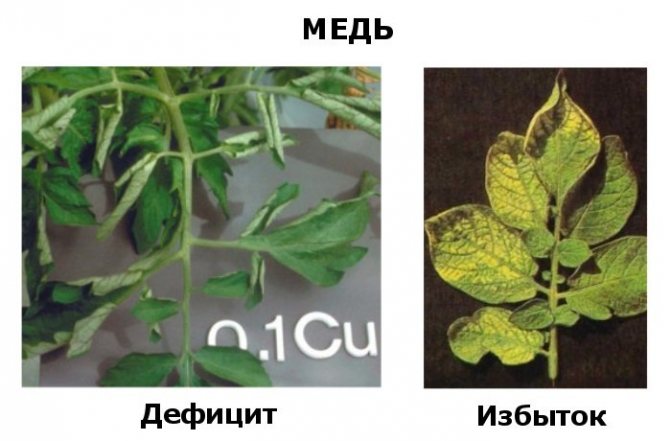

Improper watering of tomatoes
Tomatoes are a drought-tolerant crop.Despite the fact that the root system of plants is quite powerful and goes deep, the bulk of the roots that absorb moisture are close to the soil surface. Therefore, irregular watering adversely affects the plant.
Also tomatoes do not like excess moisture... Watering should be done rarely, but abundantly. In greenhouses, moisture evaporates much more slowly than in open beds, so an excess of moisture can lead to fungal diseases.


Watering a tomato should be done exclusively at the root.
Watering must be done under the root... Water that gets on the leaves causes them to turn yellow.
Diseases of tomatoes leading to yellowing of leaves
Fusarium disease (see description above)
can cause not only wilting, but also yellowing of sheets. It occurs instantly and almost immediately leads to a change in the shade of the tomato foliage. Dangerous for seedlings and adult plants. After the fight against fusarium, it is required to carefully process the entire greenhouse, since its spores are very tenacious, including on greenhouse structures.
Late blight.
It occurs during the onset of cold weather, as well as at high temperatures and high levels of humidity, in an unsuitable microclimate. The disease begins from the top of the tomato plants, when the tops turn brown and die after a while.
To help the vegetable grower, there are a wide variety of fungicides, as well as the implementation of preventive measures related to the creation and maintenance of the proper microclimate in the greenhouse and proper care.
Unbalanced diet
Both lack and excess of nutrients can cause yellowing of the leaves. It is necessary to feed on time and control the condition of the seedlings.
You can understand whether or not there are enough nutrients by the leaves:
- The lower leaves of the tomato in the greenhouse turn yellow, the young leaves look healthy, but the shoots are lethargic, grow poorly and form small leaves, without inflorescences - there is little nitrogen for plants in the soil. You can fix the problem if you feed the seedlings with nitrophos or another mixture that contains nitrogen. You can feed the plants with slurry (diluting it at a concentration of 1:10). A feature of tomato leaves with a lack of nitrogen is green veins on the leaf blades;
- You can determine the lack of potassium by the appearance of light dots on all the leaves. Later they grow larger until they turn into a large spot of light color. It is not difficult to fix the problem - feed the soil with mixtures containing potassium;
- The lack of manganese will be signaled by the upper leaves hanging down. With excessive liming of the soil, brown specks may appear. Tomatoes can be cured by using mullein or wood ash;
- With a lack of sulfur, the leaves of tomatoes turn yellow and dry in the greenhouse, and at the same time become dense;
- Lack of copper is reflected only in the yellowing of old leaves;
- With a lack of phosphorus fertilizers, the lower leaves turn yellow and then their tops die off.


Important! You need to carefully monitor the condition of the plants, since the same symptoms occur with an excess of trace elements. For this reason, you need to follow the feeding schedule. Otherwise, only transplanting tomatoes to a new place can save the plants.
Pest damage to tomatoes and yellowing of foliage
The bear and wireworm, which feed on the root of the tomatoes, lead to the yellowness of the leaves of tomatoes.
Photo of Medvedka
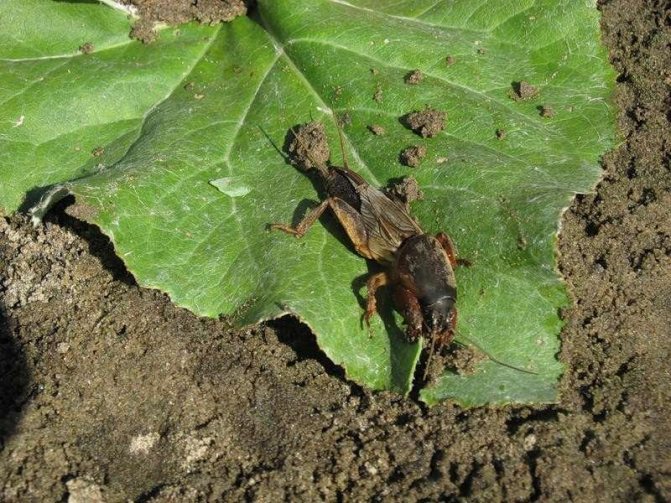

Medvedka loves the land in which organic fertilizing is introduced.
To find it, you need to dig a little in the ground, since it makes a nest at a depth of no more than 15 cm and feeds on roots from there. This leads to yellow leaves and loss of yield as a result.
To eliminate the bear, insecticides are used.
Wireworm damages tomatoes by laying larvae next to plants, which, while eating tomatoes, gradually penetrate into the stems. A mixture of sawdust, sand and Bazudin is used to eliminate the larvae.




